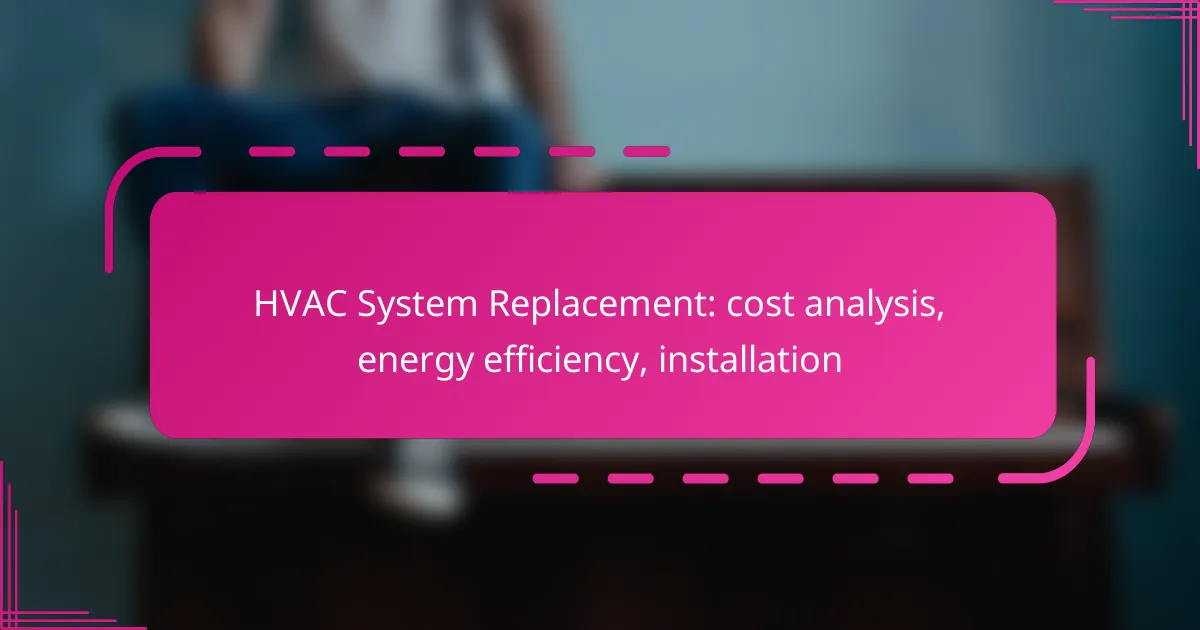Replacing an HVAC system is a significant investment that can range from a few thousand to over ten thousand dollars, influenced by factors such as system type, size, and installation complexity. Energy efficiency plays a crucial role in this decision, as opting for a more efficient system can lead to substantial savings on energy bills and a smaller environmental impact. Proper installation is essential for optimal performance, requiring professional expertise to navigate the intricacies of equipment placement and system calibration.

What are the costs of HVAC system replacement?
The costs of HVAC system replacement can vary significantly based on several factors, including system type, size, and installation complexity. Homeowners should expect to invest anywhere from a few thousand to over ten thousand dollars for a complete replacement, depending on their specific needs and local market conditions.
Average cost range for residential HVAC systems
The average cost for residential HVAC system replacement typically falls between 3,000 and 10,000 USD. This range includes both the unit and installation expenses. Factors such as system efficiency, brand, and additional features can influence the final price.
For instance, a basic central air conditioning unit may cost around 3,000 to 5,000 USD, while high-efficiency systems or those with advanced technology can reach upwards of 10,000 USD or more. It’s essential to obtain multiple quotes to find the best deal.
Factors influencing HVAC replacement costs
Energy efficiency ratings also play a significant role. Systems with higher SEER (Seasonal Energy Efficiency Ratio) ratings may have a higher upfront cost but can lead to savings on energy bills over time. Local labor rates and any necessary permits can further affect the final price.
Cost comparison of different HVAC brands
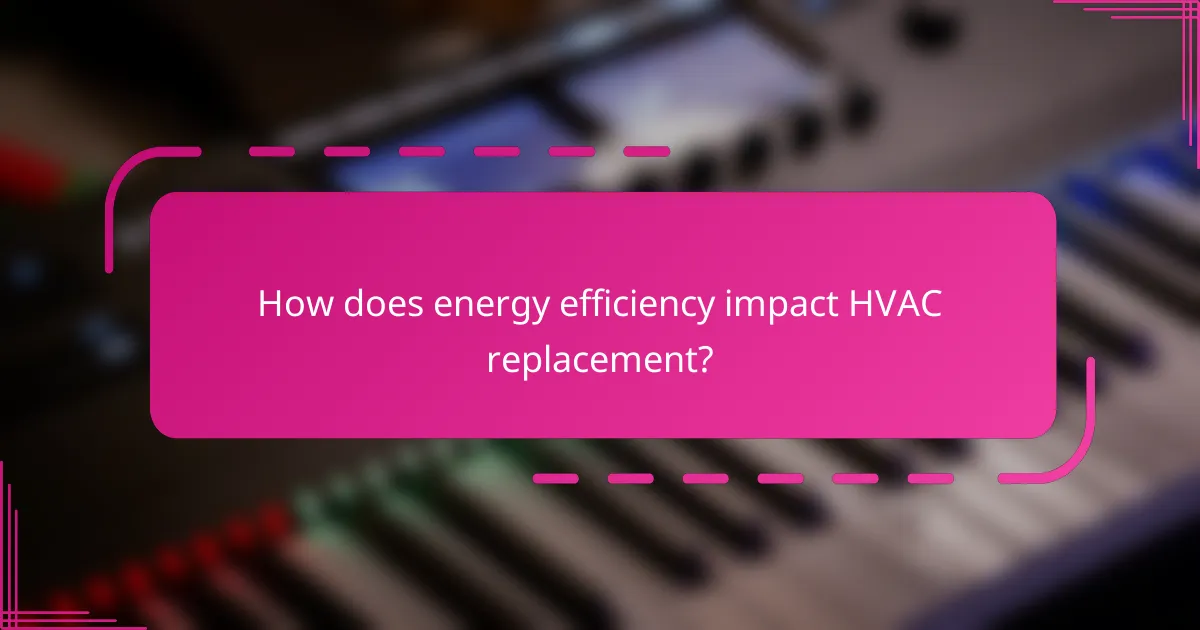
How does energy efficiency impact HVAC replacement?
Energy efficiency significantly affects HVAC replacement by influencing both upfront costs and long-term operational expenses. Choosing a more efficient system can lead to lower energy bills and a reduced environmental footprint over time.
Energy efficiency ratings explained
Energy efficiency ratings, such as SEER (Seasonal Energy Efficiency Ratio) for cooling systems and AFUE (Annual Fuel Utilization Efficiency) for heating systems, provide a standardized way to compare the performance of HVAC units. Higher ratings indicate better efficiency, meaning the system uses less energy to produce the same amount of heating or cooling.
For example, a unit with a SEER rating of 16 is generally more efficient than one rated at 13. This difference can lead to substantial savings on energy bills, especially in regions with extreme temperatures.
Long-term savings from energy-efficient systems
Investing in energy-efficient HVAC systems can yield significant long-term savings. While the initial purchase price may be higher, the reduction in energy consumption often offsets this cost within a few years. Homeowners can expect savings of 20-50% on their energy bills depending on the efficiency rating and local energy costs.
Additionally, many regions offer rebates or tax incentives for upgrading to energy-efficient systems, further enhancing the financial benefits. It’s essential to evaluate these incentives when considering a replacement to maximize overall savings.
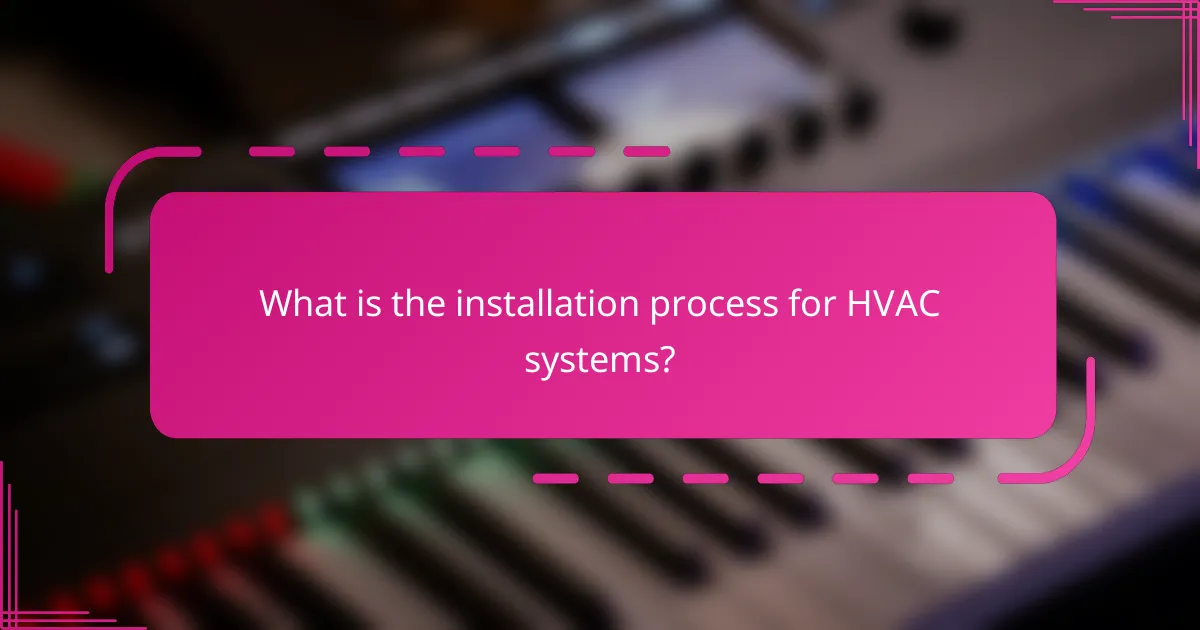
What is the installation process for HVAC systems?
The installation process for HVAC systems involves several key steps to ensure proper setup and efficiency. It typically requires professional expertise to handle the complexities of equipment placement, ductwork, and system calibration.
Typical installation timeline for HVAC systems
The installation timeline for HVAC systems can vary based on the system type and the complexity of the installation. Generally, a complete installation may take anywhere from one to three days. Factors such as the size of the home, existing ductwork, and the specific HVAC model can influence this duration.
For instance, a straightforward replacement of an existing system might be quicker, while installing a new system in a home without ductwork could extend the timeline significantly. Planning ahead and scheduling the installation during off-peak seasons can help streamline the process.
Key steps in HVAC installation
The key steps in HVAC installation include assessing the space, selecting the right system, and preparing the site. Initially, a technician will evaluate the home’s layout and existing infrastructure to recommend an appropriate HVAC solution. This assessment ensures that the chosen system meets the heating and cooling needs efficiently.
Next, the installation involves setting up the equipment, which includes placing the indoor and outdoor units, connecting refrigerant lines, and installing ductwork if necessary. Finally, the technician will test the system to ensure it operates correctly and meets local regulations.
Homeowners should also consider scheduling regular maintenance checks after installation to keep the system running efficiently and to prolong its lifespan. Avoiding common pitfalls, such as neglecting to verify system compatibility with existing infrastructure, can lead to a smoother installation experience.
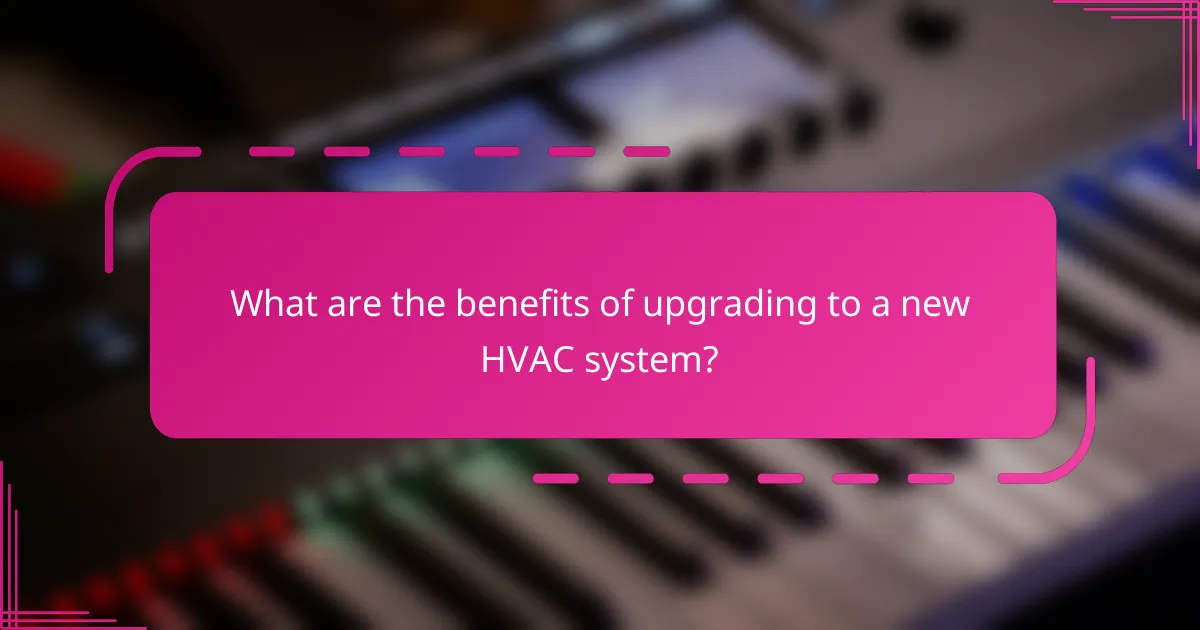
What are the benefits of upgrading to a new HVAC system?
Upgrading to a new HVAC system offers significant advantages, including improved energy efficiency and enhanced comfort. These benefits not only contribute to a healthier indoor environment but also lead to potential cost savings over time.
Improved indoor air quality
A new HVAC system can greatly enhance indoor air quality by incorporating advanced filtration technologies that capture dust, allergens, and pollutants. Modern systems often feature HEPA filters and UV light options that reduce airborne contaminants, making the air healthier to breathe.
Additionally, newer models are designed to provide better ventilation, which helps to circulate fresh air throughout the space. This is particularly important in homes with tight seals that can trap stale air and moisture, leading to mold growth and other issues.
Enhanced comfort and temperature control
Upgrading to a new HVAC system allows for improved temperature control, ensuring consistent heating and cooling throughout your home. Many modern systems come with smart thermostats that enable precise adjustments and scheduling, which can enhance comfort and reduce energy usage.
Moreover, newer systems often operate more quietly than older models, contributing to a more pleasant living environment. Homeowners can expect better zoning capabilities, allowing different areas of the home to be heated or cooled according to individual preferences.
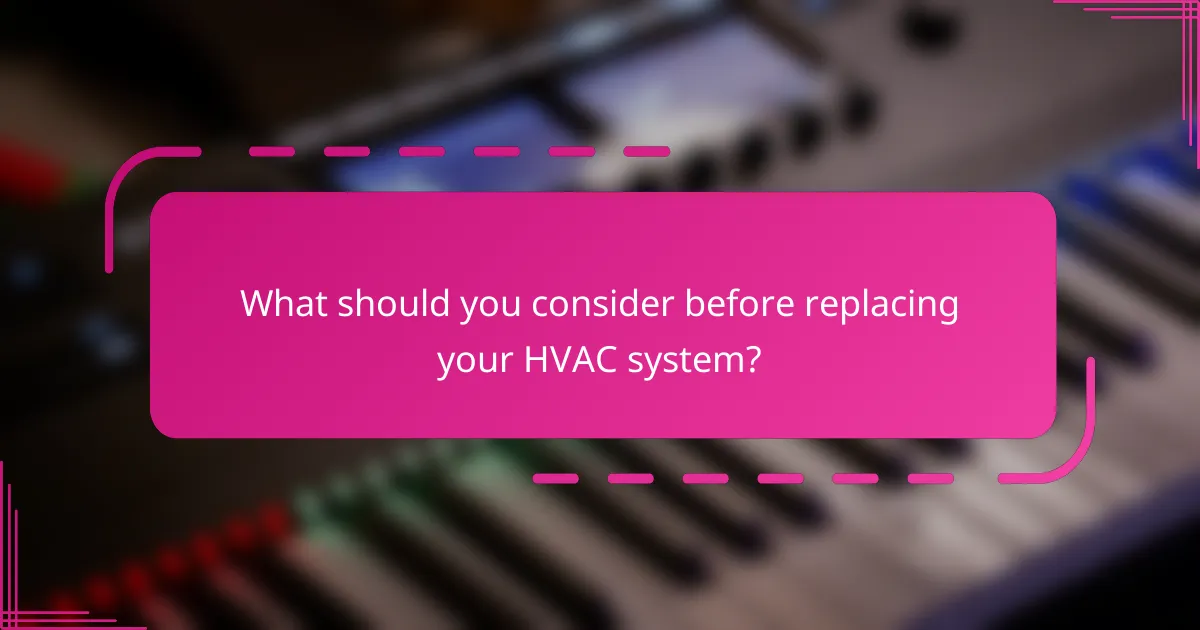
What should you consider before replacing your HVAC system?
Before replacing your HVAC system, consider factors such as the current system’s performance, your home’s size and layout, and energy efficiency. These elements will help you make an informed decision that balances cost and comfort.
Assessing current system performance
Evaluating your current HVAC system’s performance is crucial. Look for signs of inefficiency, such as inconsistent temperatures, high energy bills, or frequent repairs. If your system is over a decade old and requires constant maintenance, it may be time for a replacement.
Consider conducting a professional energy audit to identify specific inefficiencies. This assessment can reveal whether your system is underperforming due to duct leaks, outdated technology, or insufficient capacity for your home.
Evaluating home size and layout
Your home’s size and layout significantly influence the type of HVAC system you need. A larger home may require a more powerful system or multiple units to ensure even heating and cooling. Conversely, smaller spaces may benefit from compact systems or ductless options.
Take into account the layout of your home, including the number of floors and room configurations. Open floor plans may allow for more efficient airflow, while closed-off spaces might need additional zoning systems to maintain comfort levels throughout.

How do local regulations affect HVAC replacement?
Local regulations significantly impact HVAC replacement by dictating permitting processes, energy efficiency standards, and installation practices. Understanding these regulations is crucial for homeowners to ensure compliance and optimize system performance.
Permitting requirements in major US cities
Permitting requirements for HVAC replacement vary widely across major US cities. For instance, cities like New York and Los Angeles require permits for any significant HVAC work, ensuring that installations meet local codes and safety standards. Homeowners should check with their local building department to understand the specific permits needed for their area.
In some cities, the permitting process can take several weeks, so it’s advisable to plan ahead. Failing to obtain the necessary permits can result in fines and complications during inspections, potentially delaying the installation process.
Energy efficiency standards by state
Energy efficiency standards for HVAC systems differ by state, often influenced by local climate conditions and energy policies. For example, states like California have stringent energy efficiency requirements, mandating high SEER (Seasonal Energy Efficiency Ratio) ratings for air conditioning units. Homeowners in these states may need to invest in more efficient systems to comply with regulations.
In contrast, states with milder climates may have less rigorous standards, allowing for a broader range of HVAC options. It’s essential for homeowners to research their state’s specific energy efficiency requirements to avoid penalties and ensure their new system is compliant.

What are the emerging trends in HVAC technology?
Emerging trends in HVAC technology focus on enhancing energy efficiency, improving user control, and integrating smart features. These advancements aim to reduce operational costs and environmental impact while providing greater comfort and convenience for users.
Smart HVAC systems and automation
Smart HVAC systems utilize advanced technology to optimize heating and cooling based on real-time data. These systems can be integrated with home automation platforms, allowing users to control their HVAC settings remotely via smartphones or voice commands.
Key features of smart HVAC systems include programmable thermostats, occupancy sensors, and energy usage analytics. For instance, a programmable thermostat can adjust temperatures automatically based on your schedule, potentially saving 10-15% on energy bills.
When considering a smart HVAC system, evaluate compatibility with existing equipment and the potential for future upgrades. Ensure that the system can provide detailed energy reports to help you track usage and identify savings opportunities.
